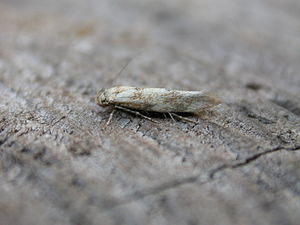Fringed moths
| Fringed moths | ||||||||||
|---|---|---|---|---|---|---|---|---|---|---|

|
||||||||||
| Systematics | ||||||||||
|
||||||||||
| Scientific name | ||||||||||
| Momphidae | ||||||||||
| Herrich-Schäffer , 1857 |
The fringed moths (Momphidae) are a family of butterflies (Lepidoptera).
features
The moths reach a wingspan of 7 to 22 millimeters. The head is covered with tightly fitting scales . The base of the antennae ( Scapus ) has a bristle comb. The eyes are medium-sized, there are no ocelles . The labial palps are quite long and curved upwards. They have no tufts of scales in front. The third segment is shorter than the second. The forewings are narrowly lanceolate to lanceolate and are usually provided with clusters of protruding scales. There are three median arteries , M 1 is sometimes stalked with R4 + 5. The hind wings are narrowly lanceolate or lanceolate linear. The wire M 1 is stalked or separated from the wire M 2 . The middle pair of spurs of the tibiae of the hind legs is located in the middle or slightly behind. The abdominal tergites II to VII are provided with special lanceolate scales that are deeply rooted and arranged laterally in two large rounded groups. The longitudinal sclerosis of the second tergite is short.
In the males, the uncus is long and narrow and connected to the well-developed triangular tegumen . The Gnathos is reduced to a somewhat rough or membranous tuber. It lies somewhat forward and is connected to the anterodorsal process of the valves . The vinculum is narrow. The saccus is short and has no pronounced protrusion in the middle. The valves are symmetrical and divided into a fine petal-like dorsal lobe (cucullus) and a heavily sclerotized ventral lobe (sacculus) with a distinct apical protrusion. Two medium-sized, finger-shaped, hairy anellus lobes ( valvellae ) are located lateroventrally on the apical part of the aedeagus. The Aedeagus is significantly shorter than the Valven. It is smooth, not sclerotized and provided with groups of cornuti.
In females, the ovipositor is medium-sized or rather short. The seminal duct merges in the middle part of the broad and more or less sclerotized ductus bursae . The copulatrix bursa is medium or small in size. It is oval and has a pair of characteristic sickle-shaped signs.
The caterpillars are quite short and thick. They are spindle-shaped and move slowly. They are colorless and turn pink before pupation. Secondary bristles are not applied.
The pupae are moderately sclerotized. The labial palps and femur of the forelegs are visible. Segments four to six of the abdomen are mobile. The Kremaster is unpaired and hook-shaped. The cocoon is spindle-shaped and double-walled.
distribution
The main focus of the family is in North and South America . About 30 species are found in the Palearctic . Only a few species are known from the Afrotropic and the Indo-Australian region. 20 species are native to Europe.
biology
The species in the family inhabit forests, where they can often be found on the edges of forests, in clearings and at the edges of roads. The caterpillars mine in leaves, stems, roots or seed pods. Some species produce plant galls or live between coiled leaves or flowers. Most of the species for which the biology is known live on the evening primrose family (Onagraceae). The caterpillars have specialized in certain host plants and even in certain parts of the plant, so knowing the caterpillar habitat is an important aid in determining the species. During the day, the moths rest on the leaves of their host plants. The entire body is pressed against the ground. They often fly in cloudy weather or before sunset. They are particularly active early in the morning. Most species overwinter in the litter layer , in the bark of old trees and in other hiding places. Sometimes they can also be found in winter.
Systematics
The external morphological features and those of the genital armature are fairly uniform within the fringed moths, at least in the Palearctic species. Most species belong to the species-rich genus Mompha . Some features of the wing veins, the genital morphology and the way of life suggest a subdivision of the genus. The fringed moths are close relatives of the Blastobasidae and other groups that have a weakly sclerotized aedeagus and a more or less well developed sacculus. These include the Stathmopodidae and the rottenwood moths (Oecophoridae).
The fringed moths are divided into 13 genera, two of which are also represented in Europe. A total of about 115 species belong to the family.
- Anchimompha Clarke , 1965
- Desertidacna Sinev , 1988
- Gracilosia Sinev , 1989
- Isorrhoa Meyrick , 1913
- Lacciferophaga Zagulyaev , 1959
- Licmocera Walsingham , 1891
- Lienigia winder , 1910
- Mompha Huebner , 1825
- Moriloma Busck , 1912
- Urodeta Stainton , 1869
- Patanotis Meyrick , 1913
- Phalaritica Meyrick , 1913
- Synallagma Busck , 1907
supporting documents
- ↑ a b c d e f g J. C. Koster, S. Yu. Sinev: Momphidae, Batrachedridae, Stathmopodidae, Agonoxenidae, Cosmopterigidae, Chrysopeleiidae . In: P. Huemer, O. Karsholt, L. Lyneborg (eds.): Microlepidoptera of Europe . 1st edition. tape 5 . Apollo Books, Stenstrup 2003, ISBN 87-88757-66-8 , pp. 25 (English).
- ↑ a b Momphidae at Fauna Europaea. Retrieved March 23, 2012
- ↑ van Nieukerken et al. (2011): Order Lepidoptera Linnaeus, 1758. In: Zhang, Z.-Q. (Ed.): Animal biodiversity: An outline of higher-level classification and survey of taxonomic richness. Zootaxa 3148: pp. 212–221 [url = http://mapress.com/zootaxa/2011/f/zt03148p221.pdf PDF]
Web links
- Determination aid of the Lepiforum for the butterfly species found in Germany, Austria and Switzerland. Momphidae (fringed moths). Lepiforum e. V., accessed on March 22, 2012 .